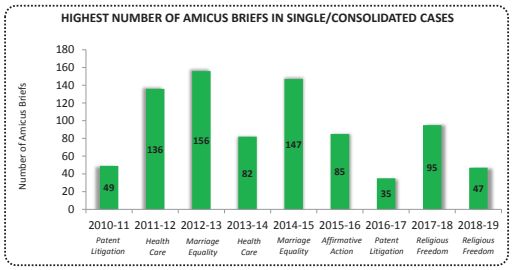Last term, amici curiae filed more than 700 briefs, participated in 96% of argued cases, and were cited by the justices in more than half of all merits cases. Twenty years ago this would've been big news, but those numbers have become routine at One First Street. If anything, friends of the court were quieter in 2018–19 than in recent terms, which have seen a record number of briefs and the highest level of amicus participation in history.
The most notable amicus development of the term had nothing to do with the briefs themselves. The Supreme Court took steps this year to gently tighten the reins on amicus practice by announcing new word limits on friend-of the-court briefs and issuing special guidance to address recurring issues with amicus submissions. See Tony Mauro & Marcia Coyle, New Guidance, for "Friends," Supreme Court Brief, Oct. 23, 2019.
Still, in our ninth year analyzing the high court's amicus curiae docket for The National Law Journal, we found that amici continued to play an important institutional role at the Supreme Court, and that certain types of briefs got noticed more than others.
No Blockbuster Amicus Cases, but Still a Mountain of Briefs

In the 2018–19 term, amici filed on average 11 briefs per case at A Calm but Impressive 2018–19 Term for 'Friends of the Court' Anthony Franze and Reeves Anderson, members of Arnold & Porter's Appellate and Supreme Court practice, review last term's Supreme Court amicus curiae docket by Anthony J. Franze and R. Reeves Anderson Anthony J. Franze R. Reeves Anderson the merits stage, down from the 2017–18 term's record 14 briefs per case. The participation rate dipped as well, with friends of the court filing briefs in 96% of argued cases, down from 100% participation in 2017–18, but within the normal participation rate from the prior eight terms, which ranged from 92 to 100%. The drop in the 2018–19 term was likely the result of fewer marquee cases that tend to attract more "friends."
Similarly, there was a drop in the highest number of amicus briefs filed in a single or consolidated case. "Cases with 30 or more amicus briefs are no longer particularly rare, and the highest-profile cases see amicus filing reaching the triple digits." Aaron-Andrew P. Bruhl and Adam Feldman, "Separating the Amicus Wheat From Chaff," 106 Geo. L. J. Online 135, 135 (2017). In 2018–19, amici did not approach triple digits, with the top case having only 47 briefs.
Unsurprisingly, cases involving hot-button issues—marriage equality, health care, religious freedom, and affirmative action—generate the most briefs, though patent cases also spur significant amicus participation. In 2018–19, amici filed the most briefs in American Legion v. American Humanist Association, a case addressing whether a war memorial shaped after a Latin cross on government-owned land violated the Establishment Clause.

Citation of 'Green' and Government Briefs
In the 2018–19 term, the justices cited amicus briefs in 56% of cases with amicus participation and signed majority opinions. That's consistent with the previous eight terms where justices cited friendof-the-court briefs in 46% to 63% of cases. The justices cited amicus briefs in 24 majority/plurality opinions, 19 dissents, 11 concurrences, and two opinions concurring and dissenting in part. These figures exclude last term's two courtappointed amici, whose submissions are more akin to party briefs. In 2018–19, the justices cited 8.5% (52/613) of the nongovernment briefs filed in cases with signed opinions. That citation rate of "green briefs"—so-called for the color of their covers—is in line with the prior eight terms, where the justices cited between 5% and 11.9% of nongovernment briefs.
Green briefs faced some criticisms in 2018–19, with one senator arguing that the funding of nongovernmental briefs needs to be more transparent. See Tony Mauro, Sheldon Whitehouse Confronts 'Anonymously Funded' SCOTUS Amicus Briefs, Nat. L. J, Feb. 5, 2019. The court's rules require disclosure of anyone who makes a monetary contribution to a brief, and the Supreme Court Clerk invoked that requirement last term to address the growing trend of amici using GoFundMe campaigns to finance briefs, requiring disclosure of the names of crowd-funding donors. See Tony Mauro & Marcia Coyle, Crowdfunded Amicus Briefs Name Donors, Supreme Court Brief, Jan. 3, 2019.
As for government amicus briefs, the justices cited 67% (18/27) of amicus briefs submitted by the Office of the Solicitor General in 2018–19, again roughly in the middle of the 44% to 81% range over the prior eight terms.
To view the full article, please click here.
Originally Published by: The National Law Journal
The content of this article is intended to provide a general guide to the subject matter. Specialist advice should be sought about your specific circumstances.

